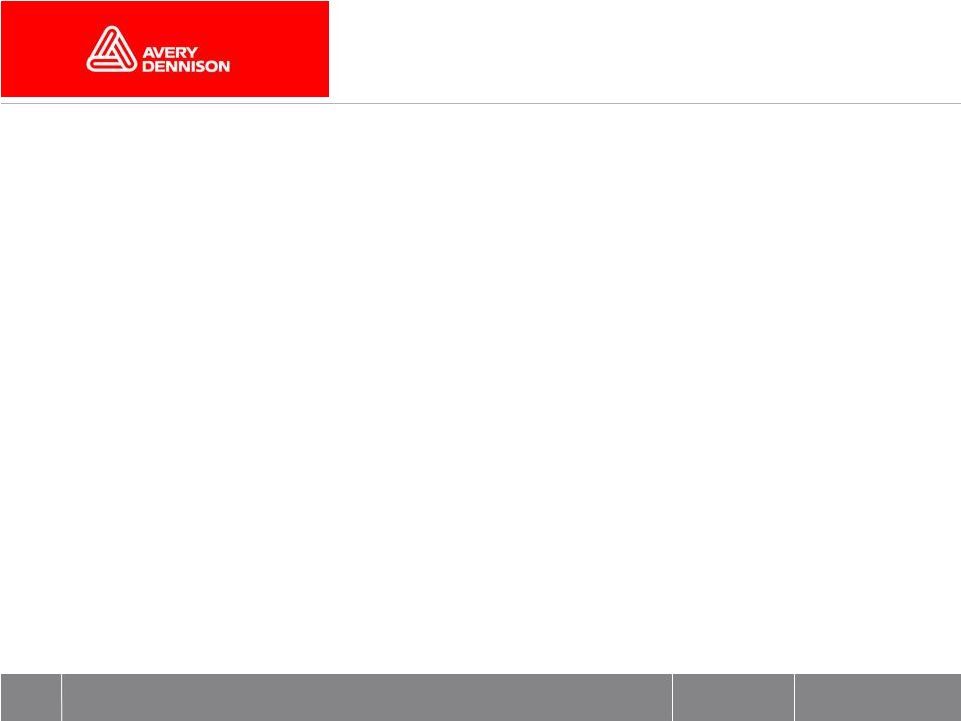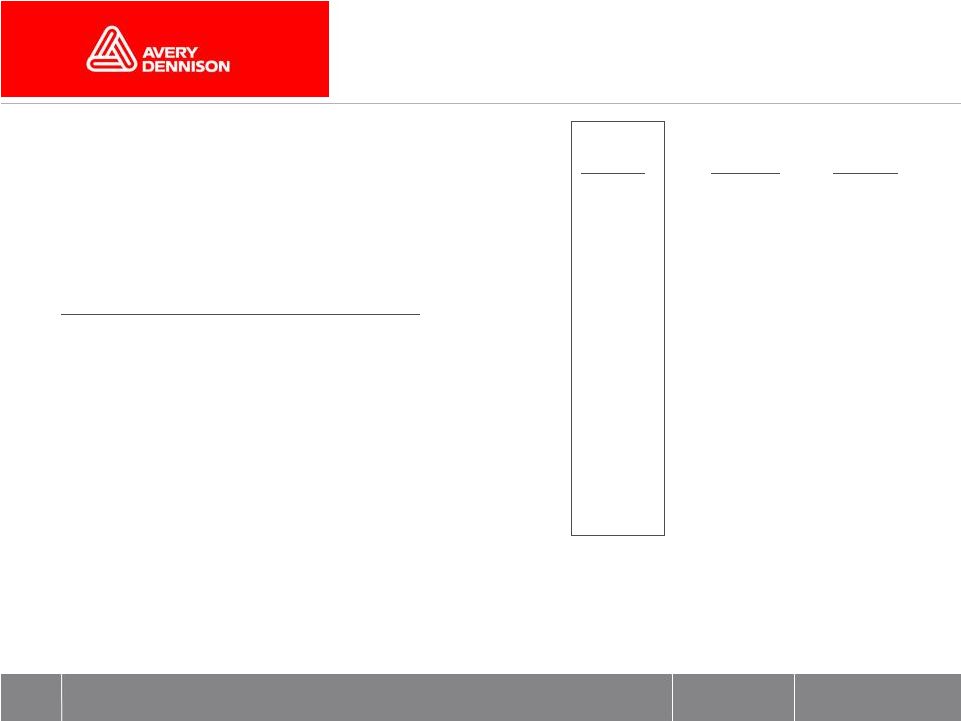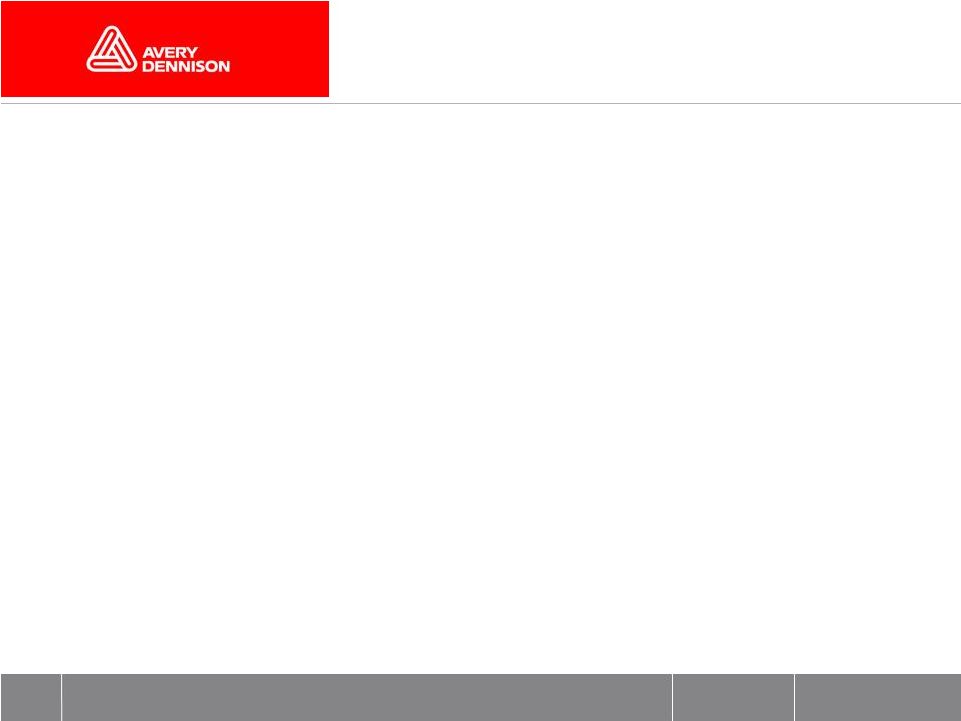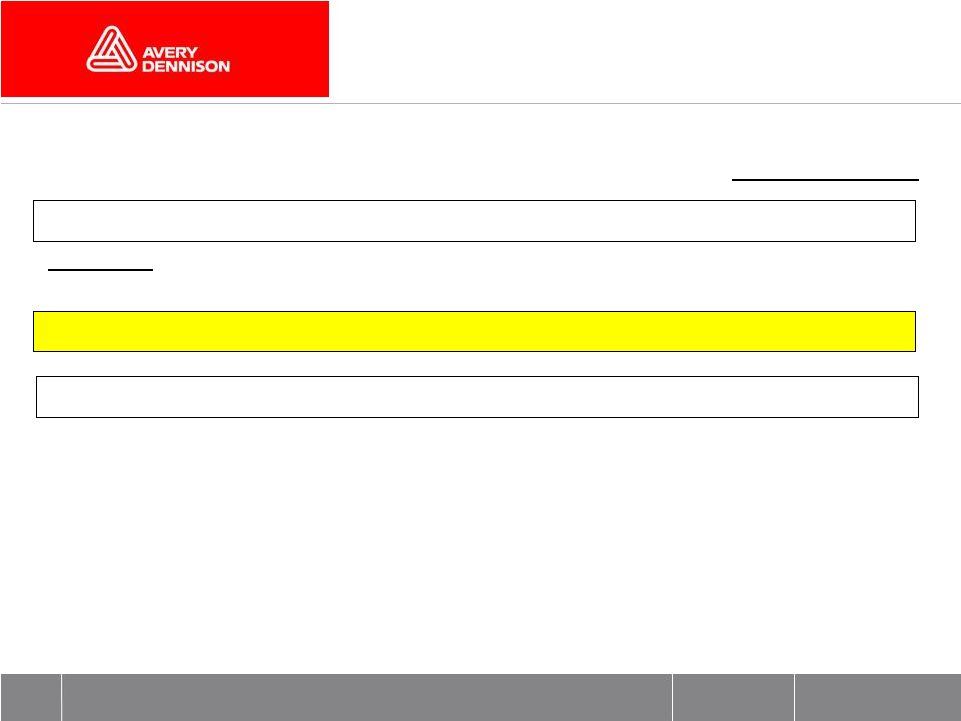Attached files
| file | filename |
|---|---|
| 8-K - FORM 8-K - Avery Dennison Corp | d8k.htm |
| EX-99.1 - NEWS RELEASE DATED JULY 26, 2011 - Avery Dennison Corp | dex991.htm |
 Supplemental Presentation Materials
Second Quarter 2011
Financial Review and Analysis
(preliminary, unaudited)
July 26, 2011 |
| Certain statements contained in this document are
"forward-looking statements" intended to qualify for the safe harbor
from liability established by the Private Securities Litigation Reform Act of 1995.
These forward-looking statements and financial or other business targets
are subject to certain risks and uncertainties. Actual results and trends may
differ materially from historical or anticipated results depending on a variety of
factors, including but not limited to risks and uncertainties relating to the
following: fluctuations in demand affecting sales to customers; the financial condition
and inventory
strategies
of
customers;
changes
in
customer
order
patterns; worldwide and local economic conditions;
fluctuations in cost and availability of raw materials; ability of the Company to
generate sustained productivity improvement; ability of the Company to
achieve and sustain targeted cost reductions; impact of competitive products
and pricing; loss of significant contract(s) or customer(s); collection of
receivables from customers; selling prices; business
mix
shift;
changes
in
tax
laws
and
regulations;
outcome
of
tax
audits;
timely
development
and
market
acceptance of new products, including sustainable or sustainably-sourced
products; investment in development activities and new production
facilities; fluctuations in foreign currency exchange rates and other risks associated with
foreign
operations;
integration
of
acquisitions
and
execution
of
divestitures; customer and supplier concentrations;
successful implementation of new manufacturing technologies and installation of
manufacturing equipment; disruptions in information technology systems;
successful installation of new or upgraded information technology systems;
volatility of financial markets; impairment of capitalized assets, including goodwill and other intangibles;
credit risks; ability of the Company to obtain adequate financing arrangements and
maintain access to capital; fluctuations
in
interest
and
tax
rates;
fluctuations
in
pension,
insurance and employee benefit costs; impact of legal
and regulatory proceedings, including with respect to environmental, health and
safety; changes in governmental laws and regulations; changes in political
conditions; impact of epidemiological events on the economy and the Company's
customers and suppliers; acts of war, terrorism, and natural disasters; and other
factors. The
Company
believes
that
the
most
significant
risk
factors
that
could affect its financial performance in the near-term
include (1) economic conditions on underlying demand for the Company's products;
(2) the degree to which higher costs can be offset with productivity
measures and/or passed on to customers through selling price increases, without
a significant loss of volume; (3) competitors' actions, including pricing,
expansion in key markets, and product offerings; and (4) tax laws,
regulations, and audits throughout the world. For
a
more
detailed
discussion
of
these
and
other
factors,
see
“Risk
Factors”
and “Management’s Discussion and
Analysis
of
Results
of
Operations
and
Financial
Condition”
in the Company’s 2010 Form 10-K, filed on February 28,
2011
with
the
Securities
and
Exchange
Commission,
and
subsequent
quarterly
reports
on
Form
10-Q.
The
forward-
looking
statements
included
in
this
document
are
made
only
as
of
the
date
of
this
document,
and
the
Company
undertakes no obligation to update the forward-looking statements to reflect
subsequent events or circumstances. |
| Use of
Non-GAAP Financial Measures This
presentation
contains
certain
non-GAAP
financial
measures
as
defined
by
SEC
rules.
Reconciliations
of non-GAAP financial
measures
to
the
most
directly
comparable
GAAP
financial
measures
are included with the financial schedules accompanying the
earnings
news
release
for
the
quarter,
along
with
certain
supplemental
analysis
provided
in
this
document.
(See
Attachments
A-2
through A-5 to Exhibit 99.1, news release dated July 26, 2011.)
The Company’s non-GAAP financial measures exclude the impact of certain
events, activities or strategic decisions. The accounting effects of
these events, activities or decisions, which are included in the GAAP financial measures, may make it
difficult to
assess
the
underlying
performance
of
the
Company
in
a single period. By excluding certain accounting effects, both
positive and negative, of certain items (e.g. restructuring costs, asset
impairments, legal settlements, certain effects of strategic transactions
and related costs, loss from debt extinguishments, loss from curtailment and settlement of pension obligations, gains
or losses on sale of certain assets and other items) from certain of the
Company’s GAAP financial measures, the Company believes that it is
providing meaningful supplemental information to facilitate an understanding of the Company’s core or
underlying operating results and liquidity measures. These non-GAAP
financial measures are used internally to evaluate trends in the
Company’s underlying business, as well as to facilitate comparison to the results of competitors for a single period. While
some of the items the Company excludes from GAAP financial measures recur, these
items tend to be disparate in amount, frequency and timing. The
Company adjusted the estimated GAAP tax rate to exclude the full year estimated tax effect of
restructuring costs and other
items
to
determine
its
adjusted
non-GAAP
tax
rate
to
derive
non-GAAP net income. (See
Attachment
A-2
to
Exhibit
99.1
for
a
discussion
of
limitations
associated
with
the
use
of
these non-GAAP financial
measures.)
The Company uses the following non-GAAP financial measures in this
presentation: •
Organic
sales
change
refers
to
the
increase
or
decrease
in
sales
excluding
the
estimated
impact
of
currency
translation;
•
Operating
margin
(non-GAAP)
refers
to
earnings
before
taxes
and
interest
expense,
excluding
restructuring
costs
and
other
items, as a percentage of sales;
•
Adjusted
(non-GAAP)
EPS
refers
to
as
reported
net
income
per
common
share,
assuming
dilution,
adjusted
for
the
full
year
estimated tax effect of restructuring costs and other items; and
•
Free
cash
flow
refers
to
cash
flow
from
operations,
less
net
payments
for
property,
plant,
and
equipment,
software
and
other
deferred charges, plus net proceeds from sale (purchase) of investments. Free cash
flow excludes mandatory debt service requirements and other uses
of cash that do not directly or immediately support the underlying business (such as discretionary
debt reductions, dividends, share repurchases, acquisitions, etc.).
This document has been furnished (not filed) under Form 8-K with the SEC and
may be found at the Company’s web site at
www.investors.averydennison.com. |
 •
Rapid change in sales trend in the second quarter
»
Consolidated unit volume down approx. 5% (vs. ~ 3.5% increase in
1Q)
due principally to lower than expected market demand in PSM and RBIS
»
OCP sales declined as expected
•
As expected, pricing and cost reduction actions offset inflation
vs. same
period last year
•
Margins negatively impacted by reduced fixed cost leverage, partially offset
by lower employee-related costs
•
Year-to-date free cash flow declined significantly due to lower operating
results
Overview: 2Q Results
Second Quarter 2011 Financial Review and Analysis
July 26, 2011
4 |
 •
Full year guidance reflects recent trends and uncertain macro environment
•
Primary driver of reduced earnings guidance is lower volume expectation
»
High end of guidance range assumes modest improvement in 2H
relative to 2Q trend
»
Low end of guidance range assumes 2Q trend continues into 3Q, with
modest improvement in 4Q
•
Raw material costs remain high
•
Accelerating cost reduction actions
•
Full year free cash flow expectation decreased due to lower operating results
•
Remain committed to maintaining a strong balance sheet and increasing
return of cash to shareholders
Overview: 2011 Outlook
Second Quarter 2011 Financial Review and Analysis
5
July 26, 2011 |
 2Q
P&L Summary 6
Second Quarter 2011 Financial Review and Analysis
•
Net sales grew approx. 3% on a reported basis (down approx. 2% before
the benefit of currency translation)
•
Operating margin (non-GAAP) declined 80 basis points to 8.2%
•
Interest expense down $3.4 mil. vs. prior year
•
Effective GAAP tax rate of 34%
»
Year-to-date adjusted tax rate increased from 23% to 29%, reflecting
geographic income mix and reduced benefit from discrete tax events
•
Reported EPS of $0.69
•
Adjusted EPS of $0.78
July 26, 2011 |
 Sales Trend Analysis
Reported Sales
Change 15.4% 5.9% 7.6%
6.7% 2.7%
2Q10
3Q10
4Q10
Organic Sales Change
14.1%
8.3% 9.0% 6.5%
(1.9%)
Currency
1.3% (2.4%)
(1.4%)
0.2% 4.6%
1Q11
2Q11
7
Second Quarter 2011 Financial Review and Analysis
July 26, 2011 |
 Gross Profit Margin (total Company)
27.3%
29.2%
27.4%
Operating Margin (non-GAAP):
Pressure-sensitive Materials
9.4%
9.6% 9.1% Retail Branding and
Information Solutions 7.4%
8.8% 3.3%
Office and Consumer Products
10.9%
15.9% 1.0%
Other specialty converting businesses
4.0% 3.1%
(0.1%)
Total Company
8.2% 9.0%
5.4%
2Q11
2Q10
1Q11
Margin Analysis
8
Second Quarter 2011 Financial Review and Analysis
July 26, 2011 |
 Key
Factors Impacting 2Q Margin •
Gross profit margin declined 190 basis points vs. prior year as the impact of
lower volume was partially offset by the benefit of productivity
actions
»
Inflation largely offset by pricing
•
Marketing, general and administrative (MG&A) expense ratio declined 110 basis
points compared to prior year
»
MG&A expense decreased approx. $9 mil. compared to prior year due
primarily to lower employee-related costs, partially offset by currency
translation and other items
9
Second Quarter 2011 Financial Review and Analysis
July 26, 2011 |
 2Q
Segment Overview PRESSURE-SENSITIVE MATERIALS
•
Reported sales of $985 mil., up 7% compared with prior year
»
Sales flat to prior year on organic basis
•
Label and Packaging Materials sales essentially unchanged on organic basis,
as volume decline was offset by pricing actions
•
Graphics and Reflective Solutions sales grew at a mid single-digit rate on
organic basis
•
Operating margin (non-GAAP) decreased slightly compared to prior year as
the impact of lower volume was mostly offset by the benefit of productivity
initiatives and lower employee-related costs
»
Price and inflation gap narrowed compared to 1Q
10
Second Quarter 2011 Financial Review and Analysis
July 26, 2011 |
 2Q
Segment Overview (continued) RETAIL BRANDING AND INFORMATION SOLUTIONS
•
Reported sales of $396 mil., down 4% compared with prior year
»
Sales down 6% on organic basis
•
Operating margin (non-GAAP) decreased by 140 basis points to 7.4% driven
by the impact of lower volume, partially offset by lower employee-related
costs and the benefit of productivity initiatives
OFFICE AND CONSUMER PRODUCTS
•
Reported sales of $204 mil., down 2% compared with prior year
»
Sales down 5% on organic basis
•
Operating margin (non-GAAP) declined to 10.9% due primarily to the effects
of lower volume and raw material inflation, partially offset by the benefit
of productivity initiatives
11
Second Quarter 2011 Financial Review and Analysis
July 26, 2011 |
 OTHER SPECIALTY CONVERTING BUSINESSES
•
Reported sales of $141 mil., up 4% compared with prior year
»
Sales flat to prior year on organic basis
•
Operating margin (non-GAAP) improved by 90 basis points as the impact of
pricing and favorable product mix more than offset the negative impact of
higher raw material costs
2Q Segment Overview (continued)
12
Second Quarter 2011 Financial Review and Analysis
July 26, 2011 |
 Contributing Factors to 2011
13
Assumptions as of 4/27/11
Assumptions as of 7/26/11
•
Organic sales growth of 1.5% to 3.5%
•
Currency translation (at June rates, represents
approx. 3% tailwind to reported sales growth;
approx. $21 mil. positive impact to EBIT vs. 2010)
•
Raw material inflation of approx. $220 mil.;
increase in inflation largely offset by additional
cost reduction initiatives and pricing actions
•
Full year OCP operating margin expected to be in
the upper single-digits
•
Increased investments in marketing, R&D, and
infrastructure (moderated due to current climate)
•
Reduction in ongoing retirement plan expenses
•
Interest expense comparable to 2010
•
Tax rate in the high-twenty percent range
•
Restructuring costs and other items of ~$30 mil.
•
Capital expenditures (including IT) of ~$150 mil.
•
Pension contributions of at least $50 mil.
Second Quarter 2011 Financial Review and Analysis
•
Organic sales growth of ~7%
•
Currency translation (at March rates, represents
approx. 3% tailwind to reported sales growth;
approx. $18 mil. positive impact to EBIT vs. 2010)
•
Raw material inflation of approx. $220 mil.;
increase in inflation largely offset by additional
cost reduction initiatives and pricing actions
•
Full year OCP operating margin expected to be in
the upper single-digits
•
Increased investments in marketing, R&D, and
infrastructure
•
Reduction in ongoing retirement plan expenses
•
Interest expense comparable to 2010
•
Tax rate in the mid-twenty percent range
•
Restructuring costs and other items of ~$20 mil.
•
Capital expenditures (including IT) of ~$175 mil.
•
Pension contributions of ~$50 mil.
July 26, 2011 |
 2011 Earnings and Free Cash Flow Guidance
2011
Guidance
Reported (GAAP) Earnings Per Share
$2.25 -
$2.55
Add Back:
Estimated Restructuring Costs and Other Items
~ $0.20
Adjusted (non-GAAP) Earnings Per Share
$2.45 -
$2.75
Free Cash Flow (before dividends)
$250 -
$275 mil.
14
Second Quarter 2011 Financial Review and Analysis
July 26, 2011 |
 |
